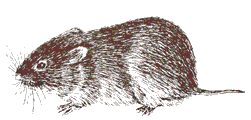Center, Internet, Wildlife Damage Management

Eastern Pine and Meadow Vole Symposia
Date of this Version
3-1-1981
Abstract
Light is an environmental variable which has considerable effect on small mammal activity patterns. This constantly repeating 24 hour signal provides information on a daily basis and has been shown to synchronize all physiological patterns in an animals existence. Laboratory studies have shown that pine voles are slightly nocturnal (Pearson, 1947) or confined their activity to the hours of twilight and darkness (Werner, 1951). Both authors indicate that activity occurs in bouts of about 1 hour duration followed by an hour of rest. Benton (1955) observed from trapping that more activity occurred at night but cautioned that due to the fossorial habit of pine voles activity could occur below ground during the day and bias the data. Continuous trapping data from both above and below ground sources indicate that there is activity both above and below ground at night but only below during the day. Activity is restricted to the burrow system. Gettle (1975) radiotelemeted pine voles and found that during any 15 minute period of the day (24 hour period), 50% of the experimental animals were moving actively. He presumed that these animals fed continuously as Boyette (1966) had previously demonstrated that they fed at all times of day or night.


Comments
Published in Proceedings of the Fifth Eastern Pine and Meadow Vole Symposium, Gettysburg, PA, March 4–5, 1981, Ross E. Byers, editor. Copyright © 1981 Cranford.